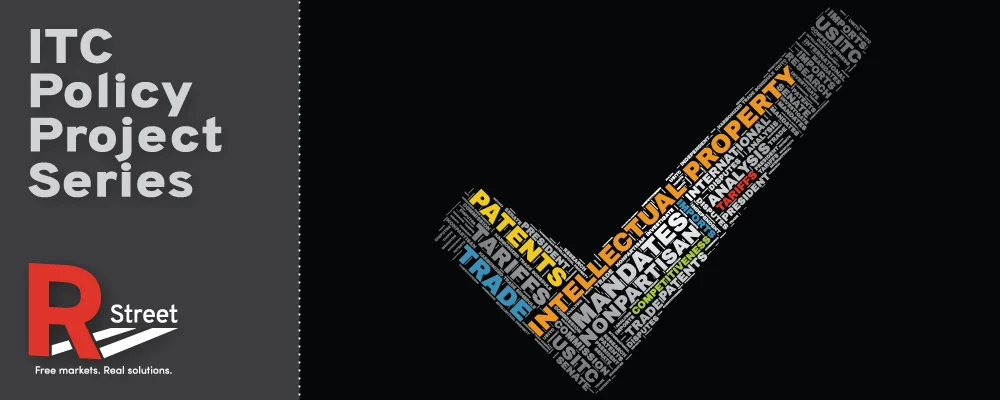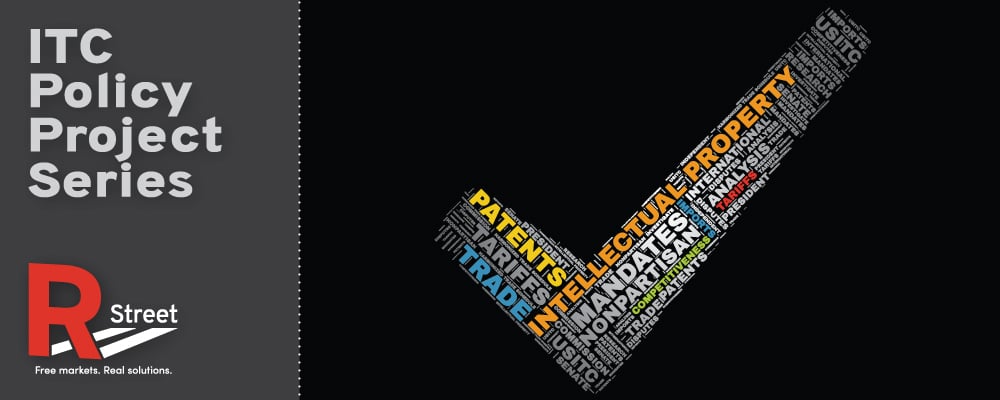ITC Policy Project Series: Domestic Industry Provisions in the Advancing America’s Interests Act
Previous posts in this series (here, here and here) have discussed particular issues with the patent-enforcement authority of the International Trade Commission (ITC). But the overarching problem may be that the ITC has become a general patent-enforcement venue instead of treating patent enforcement as an adjunct to its primary trade policy mission.
The Advancing America’s Interests Act (AAIA) revises the ITC’s patent statute, 19 U.S. Code § 1337 – Unfair practices in import trade, to refocus the ITC on trade policy by reining in its wide-ranging patent-enforcement actions.
The AAIA’s well-considered changes fall into three categories: domestic industry provisions, public interest provisions and timeliness provisions. The first category focuses ITC patent investigations on imports that harm actual domestic industry while safeguarding access for innovators. The second requires the ITC to consider the public interest more fully before issuing an exclusion order. The third provides a statutory mechanism for faster review of potentially case-dispositive issues.
This post addresses the domestic industry provisions. We will lay out the changes made to the current statute, explain the reasons behind them and use R Street’s extensive database of ITC investigations to examine the empirical case for these changes.
Revised Domestic Industry Provisions
We have written extensively regarding the current domestic industry requirement’s history and breadth and how much easier it is for non-practicing entities (NPEs) to get an exclusion order from the ITC than an injunction from a district court. As a result, NPEs and patent assertion entities (PAEs) are flocking to the ITC.
The AAIA’s domestic industry provisions would ensure that complainants have an actual domestic industry.
In the current statute, subsection 1337(a)(2) requires the patent owner to demonstrate that a domestic industry exists in the United States “relating to the articles protected by the patent” or other intellectual property. Under subsection 1337(a)(3), a domestic industry can be proved through:
(A) significant investment in plant and equipment;
(B) significant employment of labor or capital; or
(C) substantial investment in its exploitation, including engineering, research and development, or licensing.
In theory, including licensing in paragraph (C) allows the ITC to protect small inventors and universities that partner with private entities to bring new products to market. The ITC classifies these productive NPEs as “Category 1” NPEs.
The licensing provision, however, is subject to abuse. Many NPEs—particularly PAEs—rely on “licensing” that results from litigation settlements to show a domestic industry. Classified as “Category 2” NPEs, PAEs invent nothing, make nothing and produce nothing. Per the ITC, their “business model primarily focuses on purchasing and asserting patents.”
The purported licensee is typically an accused infringer who settled its case and is not interested in participating in the patent owner’s follow-on cases at the ITC. The PAE uses the settlement/license either to show a licensing “industry” under paragraph 1337(a)(3)(C) or to claim the licensee’s investment and employment as their own under paragraphs (A) and (B).
While the proposed revised statute allows patent owners to demonstrate their domestic industry through the same basic mechanisms, it limits reliance on licensing in three ways that ensure the ITC is policing trade instead of providing a general patent venue.
First, new paragraphs 1337(a)(3)(C) and (D) allow a domestic industry through licensing, but only licensing that leads to new products:
(C) substantial investment in its exploitation, including engineering, research and development; or
(D) substantial investment in licensing activities that leads to the adoption and development of articles that incorporate the patent, copyright, trademark, mask work, or design.
Under new paragraph (D), mere patent enforcement against existing products will not qualify. While this is a blow to PAEs, it allows universities and small inventors to continue to rely on licensing that benefits the public.
Second, new subsection 1337(a)(4) limits a PAE’s ability to rely on licensees’ investments and employment under paragraphs (3)(A) and (3)(B):
(4) For purposes of paragraph (3), the complainant may not rely upon activities by its licensees unless the license leads to the adoption and development of articles that incorporate the claimed patent, copyright, trademark, mask work, or design for sale in the United States.
Thus, a complainant can rely on its licensee’s activities only when the license has led to innovative new products. It precludes a PAE from asserting its litigation settlements while allowing Category 1 NPEs to rely on industry partnerships.
Third, subsection 1337(b)(1) of the current statute requires the ITC to investigate any alleged violation upon receiving a complaint.
(1) The Commission shall investigate any alleged violation of this section on complaint under oath or upon its initiative.
The AAIA adds a second sentence that bars complaints based on a domestic industry of a non-party:
(1) … For a complaint under oath, a person may be relied upon to qualify as an industry under subsection (a)(2) only if the person joins the complaint under oath, except that nothing in this sentence shall be construed to compel such a person to join the complaint …
The revision aims to end domestic industry by subpoena at the ITC by barring complaints based on the activity of non-party licensees.
These Changes Are Needed
How statistically significant are these provisions? In a word, very.
R Street has reviewed case files for the 60 ITC investigations instituted in 2022. In at least 20 investigations, the complainant relied on its licensing or its licensee’s activity to show a domestic industry. Similarly, ITC data shows NPEs (including PAEs) as the complainant in 19 of 59 investigations. (The slight discrepancy may result from how the ITC counts parallel investigations.) NPEs, by definition, don’t practice their patents. And while some may have a role in creating domestic industry, most are simply maximizing the dollar value of their patents.
Thus, about one-third of the ITC’s complaints would be scrutinized under the revised statute for evidence of an actual domestic industry that the patentee had some role in creating or maintaining. It would also bar investigations reliant on unwilling licensees who settled one case only to become embroiled in another.
As we have explained, most NPEs and all PAEs have no business at the ITC. Most have little interest in halting imports because they do not produce products. They are there to create leverage in settlement negotiations and get a settlement that greatly exceeds the damages they are entitled to in court.
There is no trade policy (or patent policy) reason for an agency to have the power to grant patentees relief that they cannot get in district court, where patent holders with no actual domestic industry are generally limited to a reasonable royalty for infringement.
These complainants should be filing patent suits in district court, not trade suits at the ITC. In fact, 16 of the 20 complainants mentioned above filed parallel litigations. This practice allows ITC complainants to seek exclusion orders while having court enforcement for monetary damages. Patent holders without an actual domestic industry should be limited to the latter.
The AAIA’s domestic industry provisions would rein in the common use of the ITC by NPEs (including PAEs) with no actual domestic industry—and Congress should enact them.


